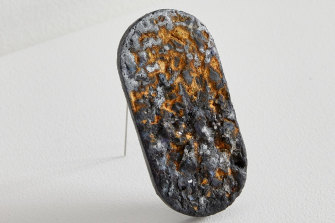The attraction of contemporary jewellery requires no explanation for those who collect it, whether it comes in the form of earrings, brooches, bracelets or necklaces.
It can be made from precious materials, such as gold or silver, but is often fashioned from far more rudimentary materials, such as aluminium, steel or even cardboard.
Cities with renowned art schools, including Munich and Amsterdam, have pioneered this type of jewellery since the early 1960s.
However, Melbourne is also recognised as an industry leader, largely due to its teaching institutions, such as RMIT and Monash University, which boast world-class gold and silversmithing courses.
Susan Cohn has been an important name in contemporary jewellery since she graduated from RMIT in 1980 and established her own Melbourne business, Workshop 3000, with jeweller Marian Hosking and technician Harry Rowlands.
Her doughnut bracelets – made from aluminium in a number of colours and designs in the early 1980s – were purchased by the National Gallery of Victoria (NGV), as well as museums including the Victoria & Albert in London.
A decade later, Cohn produced clear-plastic versions of the bracelet. Those who had the foresight to snap one up for a relatively modest price would now have to fork out up to $5000 to replace it.
“When I first started making contemporary jewellery, most people referred to me as a designer making jewellery,” Cohn says. “At that time, it really wasn’t understood.”
Other major Cohn pieces include items that looks like they have been crushed under the wheels of a truck. “People would bring in traditional jewellery they no longer wore and it was recycled and compressed into pieces, such as a brooch,” she says.
Cohn also has been instrumental in helping to showcase international contemporary jewellery to Melburnians, with a landmark exhibition, Unexpected Pleasures, staged at the NGV.
Commissioned by the Design Museum in London, it featured 260 pieces, including a crown and a motorbike helmet created for Dutch Princess Maxima by designer and countryman Ted Noten.

Melbourne is also recognised for its unique contemporary jewellery galleries, including Funaki, which opened in Crossley Lane about 25 years ago.
The internationally renowned establishment represents some of the finest contemporary jewellers from Australia, New Zealand and Europe.
“The work always starts with ideas rather than from ‘glitz’ or a brand name,” says gallery owner Katie Scott.
To demonstrate, she displays a concrete brooch by Adelaide-based jeweller Inari Kiuru.
The brooch, which sells for $880, is infused with chips of a burnt road sign from Victoria’s King Lake that experienced the 2009 “Black Saturday” disaster.
“The brooch is loaded with history,” says Scott, who sells other pieces for up to $15,000, such as a crown that can also be worn as a necklace by Swiss jeweller David Bielander. Although the pricey item looks like cardboard from a distance, it is actually made from silver and gold.
Bielander’s work will be included in the NGV’s Triennale, which brings together art, design and architecture from more than 80 artists and designers, from December 19 to April 18.
For Scott, contemporary jewellery is neither age or gender specific. “It’s quite an odd term, given it’s been going for decades. The Americans call it art jewellery.”
Scott says it appeals most to “those who know themselves, are confident to express who they are and are unlikely to have a string of pearls in the mix!”
No comments:
Post a Comment